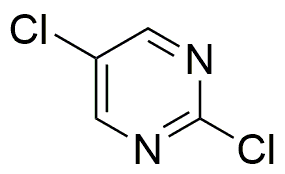2,5-Dichloropyrimidine is widely utilized in research focused on:
- Pharmaceutical Development: This compound serves as a key intermediate in the synthesis of various pharmaceuticals, particularly in the creation of antiviral and anticancer agents. Its unique structure allows for the modification of biological activity, making it valuable in drug discovery.
- Agricultural Chemicals: It is used in the formulation of herbicides and pesticides. The compound’s ability to inhibit specific enzymes in plants helps in developing effective crop protection products, enhancing agricultural productivity.
- Material Science: 2,5-Dichloropyrimidine is employed in the synthesis of polymers and other materials. Its incorporation into polymer matrices can improve thermal stability and mechanical properties, benefiting industries that require durable materials.
- Biochemical Research: Researchers utilize this compound to study enzyme interactions and metabolic pathways. Its role as a building block in biochemical assays aids in understanding complex biological processes.
- Analytical Chemistry: It is used as a reagent in various analytical techniques, such as chromatography and spectroscopy. Its distinct properties allow for the accurate identification and quantification of other compounds in complex mixtures.
General Information
Properties
Safety and Regulations
Applications
2,5-Dichloropyrimidine is widely utilized in research focused on:
- Pharmaceutical Development: This compound serves as a key intermediate in the synthesis of various pharmaceuticals, particularly in the creation of antiviral and anticancer agents. Its unique structure allows for the modification of biological activity, making it valuable in drug discovery.
- Agricultural Chemicals: It is used in the formulation of herbicides and pesticides. The compound’s ability to inhibit specific enzymes in plants helps in developing effective crop protection products, enhancing agricultural productivity.
- Material Science: 2,5-Dichloropyrimidine is employed in the synthesis of polymers and other materials. Its incorporation into polymer matrices can improve thermal stability and mechanical properties, benefiting industries that require durable materials.
- Biochemical Research: Researchers utilize this compound to study enzyme interactions and metabolic pathways. Its role as a building block in biochemical assays aids in understanding complex biological processes.
- Analytical Chemistry: It is used as a reagent in various analytical techniques, such as chromatography and spectroscopy. Its distinct properties allow for the accurate identification and quantification of other compounds in complex mixtures.
Documents
Safety Data Sheets (SDS)
The SDS provides comprehensive safety information on handling, storage, and disposal of the product.
Product Specification (PS)
The PS provides a comprehensive breakdown of the product’s properties, including chemical composition, physical state, purity, and storage requirements. It also details acceptable quality ranges and the product's intended applications.
Certificates of Analysis (COA)
Search for Certificates of Analysis (COA) by entering the products Lot Number. Lot and Batch Numbers can be found on a product’s label following the words ‘Lot’ or ‘Batch’.
*Catalog Number
*Lot Number
Certificates Of Origin (COO)
This COO confirms the country where the product was manufactured, and also details the materials and components used in it and whether it is derived from natural, synthetic, or other specific sources. This certificate may be required for customs, trade, and regulatory compliance.
*Catalog Number
*Lot Number
Safety Data Sheets (SDS)
The SDS provides comprehensive safety information on handling, storage, and disposal of the product.
DownloadProduct Specification (PS)
The PS provides a comprehensive breakdown of the product’s properties, including chemical composition, physical state, purity, and storage requirements. It also details acceptable quality ranges and the product's intended applications.
DownloadCertificates of Analysis (COA)
Search for Certificates of Analysis (COA) by entering the products Lot Number. Lot and Batch Numbers can be found on a product’s label following the words ‘Lot’ or ‘Batch’.
*Catalog Number
*Lot Number
Certificates Of Origin (COO)
This COO confirms the country where the product was manufactured, and also details the materials and components used in it and whether it is derived from natural, synthetic, or other specific sources. This certificate may be required for customs, trade, and regulatory compliance.


